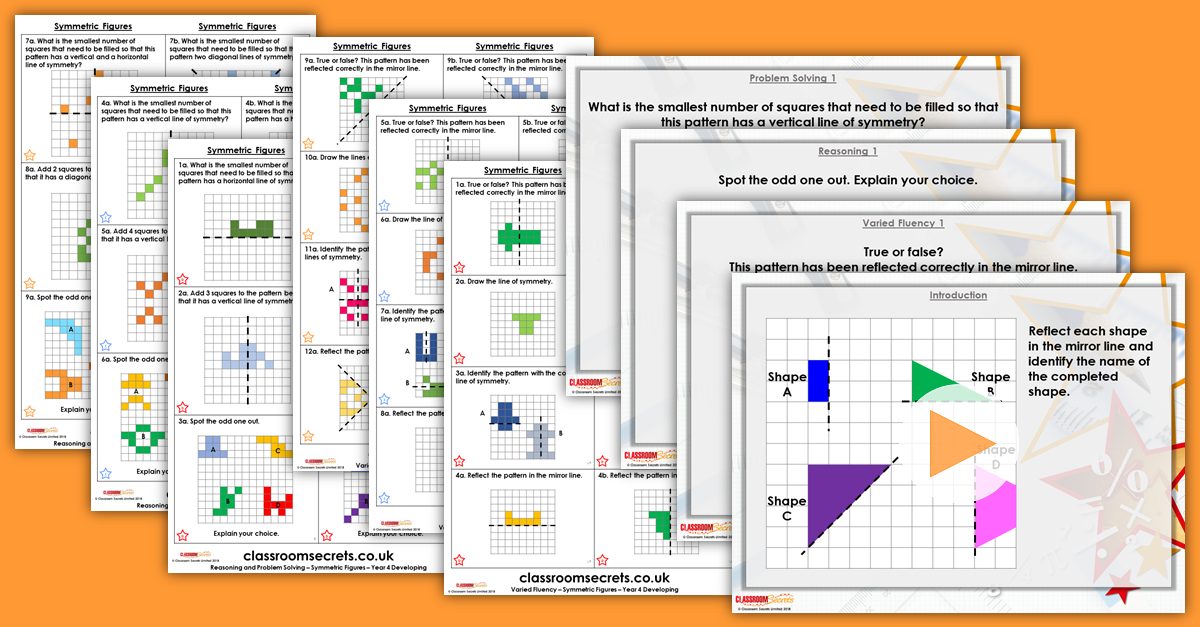Symmetric Figures Year 4 Properties of Shape Resource Pack
Step 6: Symmetric Figures Year 4 Resources
Symmetric Figures Year 4 Resource Pack includes a teaching PowerPoint and differentiated varied fluency and reasoning and problem solving resources for Summer Block 5.
Not a member? Sign up here.
[apss_share]
What's included in the pack?
This pack includes:
- Symmetric Figures Year 4 Teaching PowerPoint.
- Symmetric Figures Year 4 Fluency with answers.
- Symmetric Figures Year 4 Reasoning and Problem Solving with answers.
National Curriculum Objectives
Mathematics Year 4: (4G2b) Identify lines of symmetry in 2-D shapes presented in different orientations
Mathematics Year 4: (4G2c) Complete a simple symmetric figure with respect to a specific line of symmetry
Differentiation:
Varied Fluency
Developing Questions to support completing horizontally or vertically symmetric solid patterns, where the line of symmetry always falls on the grid line, all patterns using no more than 8 squares and arranged in a solid formation.
Expected Questions to support completing horizontally or vertically symmetric patterns, where the line of symmetry either falls on a gridline or between grid lines. All patterns using no more than 12 squares and arranged in a random formation close to the mirror line.
Greater Depth Questions to support completing horizontally, vertically or diagonally symmetric patterns, where the line of symmetry either falls on a grid line or between gridlines. All patterns using no more than 12 squares and arranged in a random formation using the whole grid.
Reasoning and Problem Solving
Questions 1, 4 and 7 (Problem Solving)
Developing Determine how many squares are needed to complete a horizontal or vertical symmetrical pattern. Line of symmetry always falls on the grid line, patterns use no more than 8 squares and are arranged in a solid formation.
Expected Determine how many squares are needed to complete a horizontal or vertical symmetrical pattern. Line of symmetry falls on or between grid lines, patterns use no more than 12 squares and are arranged in a random formation close to the mirror line
Greater Depth Determine how many squares are needed to complete a horizontal, vertical or diagonal symmetrical pattern. Line of symmetry falls on or between grid lines, patterns use no more than 12 squares and use the whole grid.
Questions 2, 5 and 8 (Problem Solving)
Developing Add a number of squares to complete a horizontal or vertical symmetrical pattern. Line of symmetry always falls on the grid line, patterns use no more than 8 squares and are arranged in a solid formation.
Expected Add a number of squares to complete a horizontal or vertical symmetrical pattern. Line of symmetry falls on or between grid lines, patterns use no more than 12 squares and are arranged in a random formation close to the mirror line.
Greater Depth Add a number of squares to complete a horizontal, vertical or diagonal symmetrical pattern. Line of symmetry falls on or between grid lines, patterns use no more than 12 squares and use the whole grid.
Questions 3, 6 and 9 (Reasoning)
Developing Find and explain which pattern is the odd one out. Line of symmetry always falls on the grid line, patterns use no more than 8 squares and are arranged in a solid formation.
Expected Find and explain which pattern is the odd one out. Line of symmetry falls on or between grid lines, patterns use no more than 12 squares and are arranged in a random formation close to the mirror line.
Greater Depth Find and explain which pattern is the odd one out. Add a number of squares to complete a horizontal, vertical or diagonal symmetrical pattern. Line of symmetry falls on or between grid lines, patterns use no more than 12 squares and use the whole grid.
This resource is available to download with a Premium subscription.







